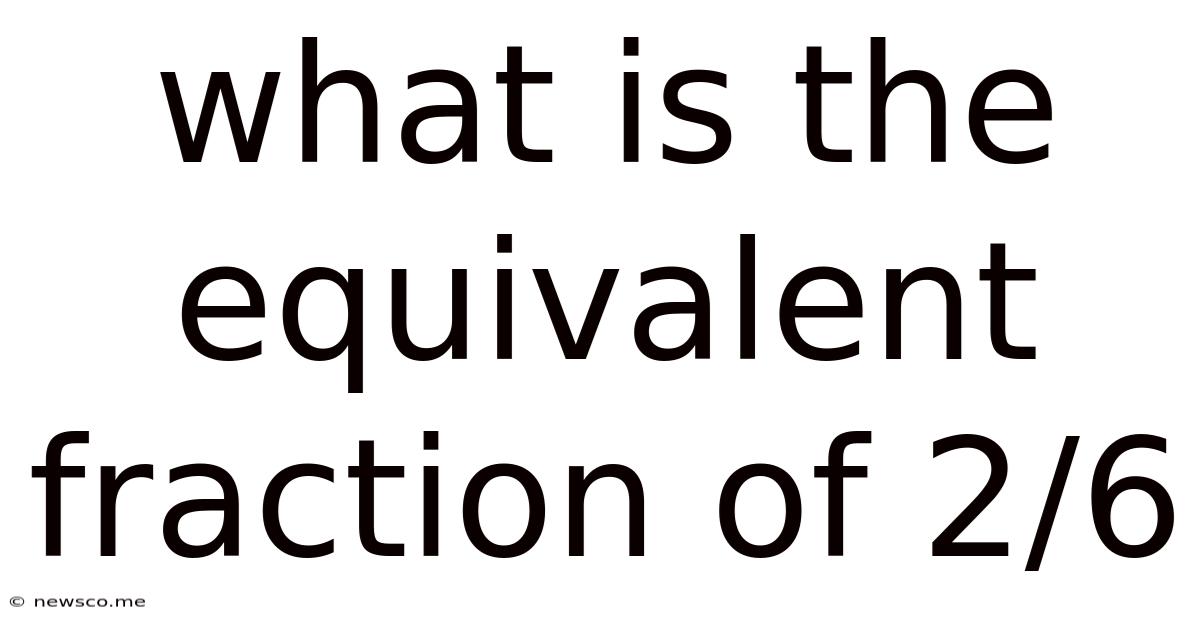What Is The Equivalent Fraction Of 2/6
News Co
Mar 18, 2025 · 5 min read

Table of Contents
What is the Equivalent Fraction of 2/6? A Comprehensive Guide
Finding equivalent fractions is a fundamental concept in mathematics, crucial for understanding fractions, simplifying expressions, and solving various problems. This comprehensive guide will explore the concept of equivalent fractions, focusing specifically on finding the equivalent fractions of 2/6. We'll delve into the process, provide numerous examples, and discuss the underlying mathematical principles. We'll also explore the practical applications of understanding equivalent fractions.
Understanding Equivalent Fractions
Equivalent fractions represent the same portion or value, even though they appear different. Think of it like cutting a pizza: you can cut a pizza into 6 slices and take 2, or you can cut it into 3 slices and take 1. You've consumed the same amount of pizza in both scenarios. This is the core idea behind equivalent fractions. They share the same value but have different numerators and denominators.
Key Concept: To create an equivalent fraction, you multiply or divide both the numerator (the top number) and the denominator (the bottom number) by the same non-zero number. This process doesn't change the fraction's overall value.
Finding Equivalent Fractions of 2/6
The fraction 2/6 represents two parts out of six equal parts. To find an equivalent fraction, we need to find another fraction that represents the same proportion. Let's explore several approaches:
Method 1: Simplification (Reducing to Lowest Terms)
The simplest equivalent fraction of 2/6 is found by simplifying or reducing the fraction to its lowest terms. This involves finding the greatest common divisor (GCD) of the numerator and the denominator and dividing both by it.
The GCD of 2 and 6 is 2. Dividing both the numerator and denominator by 2, we get:
2 ÷ 2 / 6 ÷ 2 = 1/3
Therefore, 1/3 is the simplest equivalent fraction of 2/6. It represents the same proportion – one part out of three equal parts.
Method 2: Multiplication
We can create other equivalent fractions by multiplying both the numerator and denominator by the same number. Let's try a few examples:
- Multiply by 2: (2 x 2) / (6 x 2) = 4/12
- Multiply by 3: (2 x 3) / (6 x 3) = 6/18
- Multiply by 4: (2 x 4) / (6 x 4) = 8/24
- Multiply by 5: (2 x 5) / (6 x 5) = 10/30
- Multiply by 10: (2 x 10) / (6 x 10) = 20/60
All these fractions – 4/12, 6/18, 8/24, 10/30, 20/60 – are equivalent to 2/6. They all represent the same portion of a whole.
Method 3: Visual Representation
Visual aids can help solidify the understanding of equivalent fractions. Imagine a rectangular shape divided into six equal parts. Shade two of these parts to represent 2/6. Now, imagine dividing the same rectangle into three equal parts (by combining two adjacent smaller parts). You will find that one of these larger parts is shaded. This visually confirms that 2/6 is equivalent to 1/3. You could similarly visualize other equivalent fractions like 4/12 by further subdividing the rectangles.
Practical Applications of Equivalent Fractions
Understanding and working with equivalent fractions is essential in various aspects of mathematics and everyday life. Here are some examples:
-
Simplifying Fractions: Reducing fractions to their lowest terms makes calculations easier and presents results in a clearer, more concise form.
-
Comparing Fractions: To compare fractions, it's often necessary to find equivalent fractions with a common denominator. This enables a direct comparison of the numerators. For instance, comparing 2/6 and 1/4 would be easier after finding equivalent fractions with a common denominator (such as 12).
-
Addition and Subtraction of Fractions: Adding or subtracting fractions usually requires a common denominator. Finding equivalent fractions helps achieve this.
-
Ratio and Proportion: Equivalent fractions are crucial when working with ratios and proportions. They help establish and maintain the equivalence of ratios in various problem-solving scenarios.
-
Real-World Applications: Equivalent fractions frequently appear in everyday situations like baking (adjusting recipes), dividing resources, scaling maps, understanding discounts, and many more scenarios.
Beyond the Basics: Exploring Further
While we've focused primarily on finding equivalent fractions of 2/6, the principles extend to any fraction. The ability to find equivalent fractions is a building block for more advanced mathematical concepts, including:
-
Algebra: Solving algebraic equations often involves working with fractions and simplifying expressions using the principles of equivalent fractions.
-
Geometry: Areas and volumes of shapes are frequently calculated using fractions, and simplifying these calculations involves finding equivalent fractions.
-
Calculus: Understanding fractions and their manipulations is fundamental in calculus, where limits, derivatives, and integrals often involve fractional expressions.
-
Probability: Probability is inherently based on fractions, with probabilities expressed as fractions and often requiring the simplification and manipulation of equivalent fractions.
Conclusion: Mastering Equivalent Fractions
Mastering the concept of equivalent fractions is a fundamental skill in mathematics, impacting numerous aspects of the subject and extending into various real-world applications. By understanding the process of simplification and multiplication, and by visualizing fractions, you can confidently navigate the world of equivalent fractions, simplifying calculations, solving problems, and gaining a deeper appreciation for the elegance and practicality of this essential mathematical concept. Remember, the key is to always multiply or divide both the numerator and denominator by the same non-zero number to maintain the fraction's value. Practice will solidify your understanding and make you proficient in working with equivalent fractions. The seemingly simple fraction 2/6 opens a gateway to a rich understanding of mathematical principles and their practical applications.
Latest Posts
Related Post
Thank you for visiting our website which covers about What Is The Equivalent Fraction Of 2/6 . We hope the information provided has been useful to you. Feel free to contact us if you have any questions or need further assistance. See you next time and don't miss to bookmark.